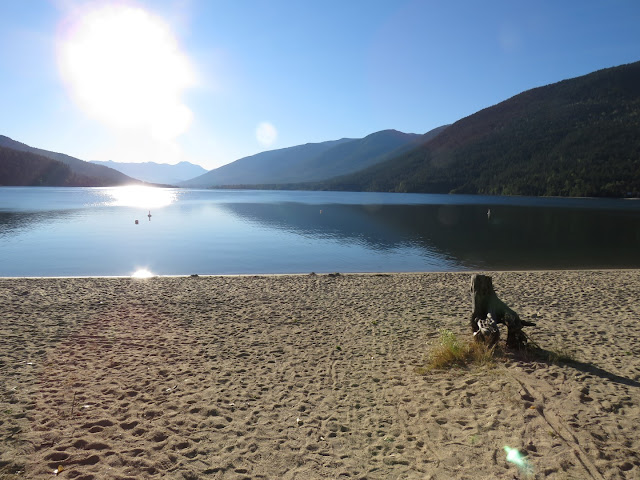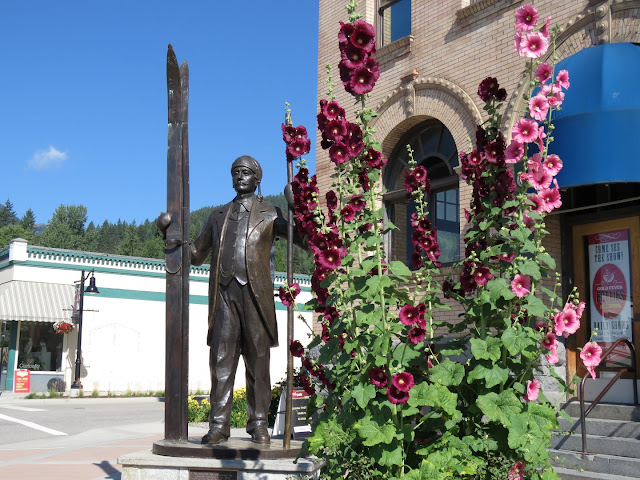Back on the road into the interior it was hard not to notice the electric blue of the cornflowers, the dusky, hot, sweet smell of the roadside ditches and some slight discolouration of tree leaves which hinted that both the end of summer and the end of our road trip would soon be upon us. We still had a couple of weeks planned to tour the Kootenay Rockies region, the only area of BC we hadn't explored on this, or, earlier trips. We had planned a circular route to take in most of the great destinations on offer: Revelstoke, Nelson, Sandon, Kaslo, New Denver, Creston, Cranbrook, Trail, Rossland and Grand Forks, among others. The Kootenays are a fairly small region in the southeast corner of the province, but, each town was remarkably different, not only in landscape, but, in looks, history and reason for being as well.
We started in
Revelstoke, home of a national park and Mount Revelstoke with its 'Meadow in the Sky' scenic drive. We didn't mind paying park fees to drive the smooth asphalt road to the top, easily accessible to all types of vehicles. We arrived at opening time to avoid the heat of the day and crowds. A short hike to the historic firetower at the summit presented us with an absolutely spectacular display of Alpine wildflower meadows.
Kaslo, sometimes called the 'Switzerland of Canada', was a pleasant surprise and we were very enamoured with this town of about 1,000 people, which, for its size, punches well above its weight. We arrived just as their annual jazz festival was about to take place and the town was buzzing. A fully-occupied, historic, bustling main street with no dollar stores or thrift shops in evidence, good restaurants, two National Historic Sites (a separate post will follow later on one of these, the SS Moyie), one of the best natural harbours on Kootenay Lake, a downtown sandy beach, spectacular mountain views across Kootenay Lake and historic houses, what's not to like? Others agree, especially whoever has made a major investment in the very nice Kaslo Hotel.
We were curious about
Nelson which seems to be on every list of 'top ten places to retire in Canada'. It was very nice, but, somehow didn't grab us.
Heading out of Nelson on the BC Day (August 1) long weekend and finding all camping sites full we soon realized we needed to find somewhere to hunker down. Luckily, Kokanee Creek Provincial Park doesn't reserve all their campsites in advance and by arriving early in the morning we were able to get a site. We spent a few days here swimming and enjoying this wonderful sand beach on Kootenay Lake in the 32C heat.

We headed out after the holiday weekend and took the free ferry across Kootenay Lake at Crawford Bay. We decided to take the scenic route across a Forest Service road to Kimberly with the caveat that we'd turn around if the road was bad. Actually, it was pretty good to the summit and we were enjoying the ride. As we started down the other side it deteriorated badly until we were driving on sharp rubble with the inevitable result, pfffft.....a flat. We'd ripped a two inch gash in the tire and were about 50 km from the nearest paved road. Luckily we had everything we needed and the tire was changed in less than an hour and we were back on our way.
Creston was another place we'd never really heard of, but, it made a big impression. It's located in an incredibly fertile valley and is foodie heaven. The many fruit stands were overflowing with fresh fruit and vegetables. The valley is home to many artisans and specialty farms, which sell direct to the public and at the weekly Saturday Farmer's market including: Quack Me Up duck farm and hatchery, Purple House farm for heirloom tomatoes, Kootenay Meadows Farm for alpine cheese, fresh glass-bottled milk and organic beef, the Pickle Patch for 30+ varieties of pickles and many, many more! It's also home to Sutcliffe Farms, Western Canada's largest asparagus farm, producing about 150,000 pounds annually. I'll never resent the high price of asparagus again when I saw how it's harvested. Think of a tractor towing about five sleds with a person laying face-down on each sled snapping off spears at ground level. They have an asparagus picker training video on YouTube:
https://www.youtube.com/watch?v=QmqegHRO-3o where you can see the fascinating process in detail. They also have some very delicious sounding asparagus recipes at
http://sutcliffefarms.com/recipes.html. Also, from their website, did you know asparagus grows depending on ground temperature, and can grow as much as 1 inch an hour. In ideal temperatures the fields may need to be picked twice a day. Creston was also home to an excellent family-run Polish restaurant. The day was overcast with a few showers when we visited, very appropriate weather for a hot bowl of borscht and a feast of pierogies, cabbage rolls and goulash wrapped in a large, crispy-brown potato pancake.
Rossland was also a delightful surprise. Another gold rush town, it has many historic buildings and about 3,500 residents. The main street was full of thriving businesses and positively gleamed as the road and sidewalks had been just rebuilt. Many buildings had made facade improvements and demonstrated pride of ownership. Just five minutes from town is Red Mountain ski resort, the nursery where Olympic skiing gold medalists Nancy Greene and Kerrin Lee Gartner both cut their teeth. Rossland was the site of the first ski competition ever held in Canada in 1897 and there is yet another Norwegian connection. Olaus Jeldness, a celebrated Norwegian, was the organizer of the race and won it becoming Canada's first national champion. His skis are in the Rossland Museum's Western Canada Ski Hall of Fame and this statue of him is prominently displayed on the main street.
Last stop on the circuit was
Osoyoos, home to Osoyoos Lake and the only true desert in Canada. We had wanted to visit the Desert Centre, but, true to form, the temperature was 38C when we went through and it was too hot to think of doing anything but getting out of town to cooler temperatures, fast!
 CONTINUE READING
CONTINUE READING







































